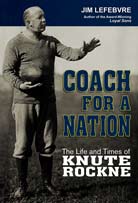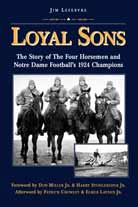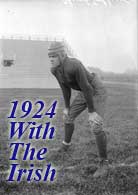When Notre Dame and Army meet Saturday night in the first football game played at the New Yankee Stadium in the Bronx, one of the classic series in college football history will be renewed for the 50th time.
But to a great many of today’s football fans, it’s just that – history. They have no living memory of what this matchup represents. Indeed, only three of the previous 49 meetings occurred in the past 25 years.
Even Notre Dame Coach Brian Kelly sounds a little sketchy on any details.
“Ronald Reagan being George Gipp, watching that movie, knowing they played Army, that’s probably about it for me,” he was quoted as saying this week.
There’s some rich irony. The episode in the ND-Army history most subject to question as to its authenticity – coach Knute Rockne’s “recollection” of Gipp’s supposed death-bed exhortation for the “boys” to overcome the breaks and “win just one for The Gipper” – remains what most fans identify with Notre Dame-Army.
It’s too bad, because the rest of the story is so full of the great stuff that makes Notre Dame football fascinating.
Through the 1920s, 30s and 40s, there was no bigger sporting event in the land. Notre Dame-Army. The essence of history in the making. The sidelines at Yankee Stadium jammed with photographers, newsreel men, and assorted celebrities and hangers-on. Tickets precious as heirlooms. Breathless radio announcers and screaming newspaper headlines carrying the action to millions across the country.
It All Began on the Diamond
It is ironic, yet fitting, that this great football spectacle was for so long contested in the crown jewel of the nation’s baseball parks, Yankee Stadium. That’s because it was baseball that first brought the two schools together. In January, 1913, Army agreed to host Notre Dame during ND’s spring trip. On May 24 at West Point, Army defeated Notre Dame, 3-0, and a rivalry began.
Also that spring, the leaders of athletics at West Point were scrambling to fill an opening on their football schedule. Army sent numerous letters of inquiry to schools in the East and eventually the Midwest. It initially offered Notre Dame $600 to cover expenses for the trip, and after some haggling, upped the offer to $1,000.
That was barely enough to send 18 players and two coaches via railroad from South Bend to New York. It was said the team brought sandwiches made on the Notre Dame campus, and traveled with just 14 pairs of cleats.
At West Point on the afternoon of Nov. 1, 1913, the 3,000 spectators who had gathered to watch the parade of the Corps of Cadets and then filled the Cullum Field Hall bleachers, were looking forward to a match of power football. Notre Dame had romped through its first three opponent by a combined score of 169-7. Army was also undefeated.
Knute Rockne, the Irish end and captain, is limping late in the first quarter. But on the next play, he streaks downfield, and quarterback Gus Dorais lofts a long pass over the heads of the defenders. Rockne catches it in stride and races to the end zone. Before the afternoon was done, the Irish completed 14 of 17 passes for 243 yards – numbers unheard of at at the time. The final: Notre Dame 35, Army 13.
Witnesses marvel at the display. “I’ve always believed such playing possible under the new rules,” said Bill Roper, the Princeton coach and the game’s umpire. “But never have I seen the forward pass used to such perfection.”
The Crowds Build at West Point
Over the next several seasons, as both schools took their place among the nation’s elite football squads, the annual Army-Notre Dame battle at West Point drew increasing interest. Crowds packed the expanding bleachers, and New York newspapers sent their top football writers to cover the game. Their dispatches went nationwide and helped create a tremendous following for the series.
The games were hard-fought and closely-contested, with only occasionally one-sided results, such as Army’s 30-10 win in 1916, or Notre Dame’s 28-0 triumph in 1921. Before and after the 1921 game, there was lively discussion among coaches and officials over Notre Dame’s shift, which opponents said skirted the rules and nearly had the backfield in continual motion. Coach Rockne maintained the players came to a brief halt, making it all legal.
By the 1922 game, Army coach Charlie Daly had adapted the Notre Dame Shift and the Cadets presented a free-wheeling offense to challenge the Irish. By now, special trains were arranged to bring fans from New York City up to West Point. The bleachers at Cullum were expanded even more, but were overflowing from the crowd estimated by some at 20,000.
The Hudson River valley, in full fall color, was a stunning setting for college football. But the increasing popularity of both West Point football, and especially the Army-Notre Dame game, necessitated changes. Plans began at the Academy for a permanent football stadium, and the game with Notre Dame needed an even larger stage.
The 1922 game developed into a bruising battle of hard hitting and rough play. Early in the second quarter, a series of jarring hits caused four fumbles – two by each team – in just several minutes. At the half, it remained a scoreless tie.
Well into the fourth quarter, it remained 0-0. Army’s Ed Garbisch trotted onto the field to attempt a 44-yard placekick that sailed straight and end-over-end but fell short of the crossbar. Racing the clock, the Irish advanced into Army territory, and on fourth down, Paul Castner attempted a drop-kick from 55 yards for the win. The Army line surged one more time and blocked the kick. Army recovered the ball as darkness enveloped the field. There was even talk of calling the game, but the Cadets had time for one final push.
There was time for one last game-winning field-goal attempt. Garbisch set up for a 40-yard kick from a difficult angle. The Irish defensive line, which had matched Army all day, was not about to let the Cadets score on the last play of the game. The kick was blocked, and the game ended in a scoreless tie.
The Game Moves to The City
When the 1923 football season started, all that was certain about the October 13 Army-Notre Dame game was that it would not be played at West Point. The actual site remained a question. The World Series between the Giants and the Yankees meant the Polo Grounds and the new Yankee Stadium would be in use. The Brooklyn Robins offered their stadium, Ebbets Field, and representatives of both schools agreed. A capacity crowd of 35,000 packed the stadium, with thousands more mobbed outside hoping to gain admission.
The great crowd slowed the march of the Corps of Cadets from Prospect Park Plaza to Ebbets Field. On this day, it would be the guile of Irish quarterback Harry Stuhldreher and his mates that would confuse Army and dazzle the spectators, in a 13-0 Irish victory.
In 1924, the game would switch venues to the Polo Grounds, where the Giants had just completed the World Series. On game day, throngs arrived from a distance and appeared as columns of determined ants converging on the great stadium from several directions. The ticket booths were jammed by customers who hadn’t availed themselves of the advance ticket sale.
Spread below was the green grass and green grandstands of the Polo Grounds. It was almost as though the Emerald Isle was smiling on the Irish. The crowd included Irish-Americans eager to see Notre Dame. Others were drawn by the prospect of seeing two powerful gridiron elevens match wits, strategy and strength. And still others looked forward to the great spectacle and pageantry of the day.
As for the football, Notre Dame swept up and down the field with a dizzying array of fakes and intricate plays. The result was a 6-0 halftime lead. Up in the wooden press box, newspaper men were marveling at the precision and skill shown by Notre Dame in the second quarter. One group of sportswriters included some of the biggest names in the business. Grantland Rice of the New York Herald Tribune and syndicated column fame was holding court.
The conversation revolved around the exceptional work of the Notre Dame backfield in thwarting Army at every turn. “Yeah, just like the Four Horsemen,” piped up young George Strickler, ND’s student publicity man, recalling a movie the team had watched that week. No reaction was noted from among the professional scribes.
After Notre Dame’s 13-7 victory, Rice penned some of the most famous words in sports history:
“Outlined against a blue-gray October sky, the Four Horsemen rode again. In dramatic lore they are known as Famine, Pestilence, Destruction and Death. These are only aliases. Their real names are Stuhldreher, Miller, Crowley and Layden. They formed the crest of the South Bend cyclone before which another fighting Army football team was swept over the precipice at the Polo Grounds yesterday afternoon as 55,000 spectators peered down on the bewildering panorama spread on the green plain below.”
The nickname stuck, aided by a famous publicity photo and a perfect 10-0 season culminating in a Rose Bowl victory. The Four Horsemen entered football lore.
On to “The House That Ruth Built”
In 1925, the rivalry reached the biggest stage of them all – Yankee Stadium, the House the Ruth Built. A crowd in excess of the 65,000-seat capacity, with many more turned away, braved a steady rain to watch Army extract some revenge with a 27-0 victory.
That started a run of 22 years in which the big game was played at Yankee Stadium, with just one exception, the 1930 tilt at Chicago’s Soldier Field. It included a number of classic matchups, with both teams ranked among the nation’s best.
In 1926, the Irish used the “perfect play” to score a 7-0 victory. Decades before the “Wildcat” the center snap went to left halfback Christy Flanagan, who swept right and picked up perfect blocks from the other three backs, and pulling linemen, to ramble 63 yards for the game’s only score.
Two years later, in 1928, reports of the game do not mention whether Rockne called upon the ghost of George Gipp to rally his troops. It’s certainly plausible, though maybe not as dramatically as portrayed in “Knute Rockne, All-American.” But the fact remains the Irish played an inspired second half, and pulled out the game with an improbable finish.
Late in the fourth quarter, the Irish lost 16 yards on an errant snap from center, and were facing a third-down-and-26 from the Army 32-yard-line. Rockne sends in subs at halfback and left end, barely noticed. Left half Johnny Niemiec takes the snap, fades to the 43, and lofts a high, floating pass toward the left sideline. The receiver has gotten his defender off-stride, and makes a lunge and reaches out his arms for the ball. He snares it as he crosses the goal line for the winning touchdown, then calmly trots back to his spot on the ND bench. And so constitutes the playing career of Johnny “One Play” O’Brien. Irish win, 12-6.
Year after year, the Notre Dame-Army game gives fans a year’s worth of highlights to remember. In 1929, the Irish complete a perfect national-championship season with a 7-0 victory on Jack Elder’s 96-yard interception return of what seemed a sure Army touchdown.
Even after Rockne’s death in an airplane crash on March 31, 1931, the series served up classic moments in the annual clash at Yankee Stadium. In 1933, the Irish trailed 12-0 heading into the fourth quarter, and 12-6 in the closing minutes. Edward “Moose” Krause has come close to blocking Army punts all afternoon. On a final try, Moose draws a double-team block, clearing the way for teammate Wayne Millner to come in clean, block the kick and pounce on it in the end zone. Final: ND 13, Army 12.
A Parade of Heisman Winners
The 1940s brought some unforgettable games, featuring Notre Dame teams coached by Frank Leahy, and star players including Heisman Trophy winners Angelo Bertelli (1943) and Johnny Lujack (1947). Army countered with some of strongest teams ever field in college football history, led by their own pair of Heisman winners, Mr. Inside and Mrs. Outside, Doc Blanchard and Glenn Davis.
Army’s war-year teams of 1944 and 1945 put on dramatic displays of football prowess, winning by scores of 59-0 and 48-0. By 1946, with football players mustered out of the armed services and back on college campuses, Leahy had interested quite a few talented ones to give Notre Dame a try.
So it was No. 2 Notre Dame taking on top-ranked Army on Nov. 9, 1941. Army had won 25 straight games. Leahy posted a sign showing the scores of the previous two years to rile up his squad.
What ensued was a tremendous back-and-forth battle, with the teams going up and down the field, only to be stymied. ND’s Terry Brennan ended one Army drive with an interception on the Irish eight-yard-line. Later, a long Army passed was picked off by Red Sitko, who promptly fumbled, only to see Lujack pounce on the ball.
When it was over, the two great powers remained scoreless.
A few weeks later, the schools announced that the series would be interrupted after the 1947 game, in which Army would make its first trip to South Bend. The schools’ joint statement said the game “had grown to such proportions that it had come to be played under conditions escaping the control of the two colleges, some of which were not conducive to wholesome intercollegiate sport.” Also, it was said, Army needed greater scheduling flexibility to meet intersectional opponents across the nation.
The series resumed with intermittent pairs of games – one in South Bend, the other in various locales in the East, including Philadelphia, Shea Stadium, and Giants Stadium. The final meeting at Yankee Stadium was a 45-0 Notre Dame victory in 1969. The rivalry even returned to West Point, where the eighth-ranked Irish scored a 62-3 win at Mitchie Stadium in 1973.
The two most recent games in the series were played at Notre Dame Stadium, including the 2006 meeting in which the No. 6 Irish led by Brady Quinn and company donned green jerseys to celebrate Senior Day and roll to a 41-9 victory.
Portions of this article are excerpted with permission from the award-winning book Loyal Sons: The Story of The Four Horsemen and Notre Dame Football’s 1924 Champions (copyright, Great Day Press, 2008) by Jim Lefebvre.






